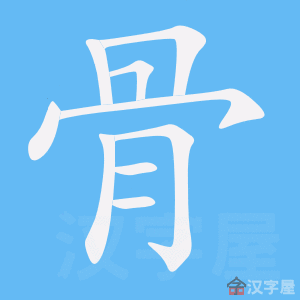|
額骨
é gǔ
|
frontal bone (forehead)
|
|
顱骨
lú gǔ
|
skull (of a dead body)
|
|
颞骨
niè gǔ
|
temporal bone;
os temporale
|
|
顳骨
niè gǔ
|
temporal bone;
os temporale
|
|
顴骨
quán gǔ
|
zygomatic bone (cheek bone)
|
|
風骨
fēng gǔ
|
strength of character;
vigorous style (of calligraphy)
|
|
骨刻
gǔ kè
|
carving in bone
|
|
骨力
gǔ lì
|
strength;
vigorous (calligraphy)
|
|
骨器
gǔ qì
|
bone tool (archaeology)
|
|
骨子裡
gǔ zi lǐ
|
beneath the surface;
fundamentally;
at the deepest level
|
|
骨幹
gǔ gàn
|
diaphysis (long segment of a bone);
fig. backbone
|
|
骨干网路
gǔ gàn wǎng lù
|
backbone network
|
|
骨幹網路
gǔ gàn wǎng lù
|
backbone network
|
|
骨感
gǔ gǎn
|
bony;
skinny
|
|
骨料
gǔ liào
|
aggregate (sand or gravel used in concrete 混凝土)
|
|
骨朵
gǔ duǒ
|
club (ancient stick-like weapon);
(flower) bud
|
|
骨殖
gǔ shi
|
skeletal remains;
Taiwan pr. [gu3 zhi2]
|
|
骨氣
gǔ qì
|
unyielding character;
courageous spirit;
integrity;
moral backbone
|
|
骨法
gǔ fǎ
|
bone structure and physiognomy;
the strength observed in brushstrokes (Chinese calligraphy)
|
|
骨灰龛
gǔ huī kān
|
columbarium
|
|
骨灰龕
gǔ huī kān
|
columbarium
|
|
骨炭
gǔ tàn
|
bone black;
animal charcoal
|
|
骨烬
gǔ jìn
|
bones and ashes;
remains (after Buddhist cremation)
|
|
骨燼
gǔ jìn
|
bones and ashes;
remains (after Buddhist cremation)
|
|
骨片
gǔ piàn
|
spicule
|

